Sacrificed stone
J-suteishi (ÞתÆà´), C-qizi (?í)£¬K-»ç¼®(Þ×à´)
Stones intentionally given up in order to serve a bigger purpose.
 Dia. 1
Dia. 1  Dia. 2
Dia. 2
Black 1 and 3 in Dia. 1 are sacrificed. By giving up these two stones with the sequence in Dia. 2, Black can make his stones on the outside thick.
Sacrifice strategy
J-sute ishi senjutsu (Þ×à´íÂîú), C-qizi zuozhan (?ííÂ?), K-»ç¼®ÀÛÀü(Þ×à´íÂîú)
A strategy in which a player sacrifices a stone (or stones) to help in building influence, taking profit, or retaining sente.
 Dia. 1
Dia. 1  Dia. 2
Dia. 2
White sacrifices his stone at 1 in Dia. 1 in order to make influence. While Black is capturing this stone, White can play 5 and 7 in Dia. 2 in sente.
Sealing
J-fujite (Üæâ¢), C-fengshou (Üæâ¢), K-ºÀ¼ö(Üæâ¢)
To envelop the last move of the day.
In a two-day title-match game, the last move of the day is not actually played on the board. Instead it is kept in a sealed envelope that is opened just before the game resumes the next day. The last move can be called ¡®sealed move.¡¯
Seki
See dual life.
Self-atari
J-damezumari (öîÙͪºªÞªê), C-zi zhuangjinqi (í»ÓÕ??), K-ÀÚÃæ(í»õö)
A state of stones in which one cannot play a meaningful move because it causes an atari to his own stones.
In Dia. 1, Black cannot play ¡®a¡¯ to give White double ataris because his stones will be in atari.
 Dia. 1
Dia. 1
The Korean ¡®ÀÚÃæ(í»õö)¡¯ and the Chinese zi zhuang jin qi (í»ÓÕ??) literally mean ¡®filling one¡¯s own liberty.¡¯
Double self-ataris
Black in Dia. 1 wants to capture the white stones in the middle, but he can play neither ¡®a¡¯ nor ¡®b.¡¯ In this case Black is said to be in ¡®double self-ataris.¡¯
 Dia. 1
Dia. 1
Sente
J-sente (à»â¢), C-xianshou (à»â¢)£¬K-¼±¼ö(à»â¢)
1. A move that requires the opponent¡¯s answer.
2. A state in which one can force the opponent to answer every move in a certain sequence and then play elsewhere.
3. The privilege of not having to answer the opponent¡¯s last move and being able to choose freely where to play next.
Also it is called the ¡®initiative¡¯ or ¡®having the initiative.¡¯ The opposite is ¡®gote.¡¯
Sente endgame
An endgame move that forces the enemy to answer and keeps sente.
 Dia. 1
Dia. 1
White 1 and 3 are sente endgames moves. After Black plays 6, White can play elsewhere.
Unilateral sente endgame
J-katasente (ø¸à»â¢), C-danxian (?à»)£¬K-Æí¼±¼ö(ø¸à»â¢)
A position in which only one player can play an endgame sequence in sent. If the other player tries to prevent this, he ends in gote.
 Dia. 1
Dia. 1  Dia. 2
Dia. 2
In Dia. 1, Black can play 1 and 3 in sente, while White plays 1 and 3 in gote in Dia. 2. In this case, the position is called as ¡®unilateral sente endgame¡¯ for Black. It is an important factor when a player estimates the estimated his total territory from the current outline. Because it is more plausible for Black to play the endgame sequence than White, Black calculates his future territory as in Dia. 1.
Bilateral sente endgame
J-ryosente (å»à»â¢), C-shuangxian (?à»), K-¾ç¼±¼ö(å»à»â¢)
A sente endgame play for both sides.
 Dia. 1
Dia. 1  Dia. 2
Dia. 2
Sequence
J-tejun (â¢â÷), C-xingqi shun xu (ú¼Ñ¤?ßí)£¬K-¼ö¼ø(â¢â÷)
An order of moves.
Sequential magic
J-tejun no myo (â¢â÷ªÎÙØ), C-shunxu jingmiao (?ßíïñÙØ)£¬K-¼ö¼ø(â¢â÷)ÀÇ ¹¦(ÙØ)
Gaining a better result by changing the order of moves.
 Dia. 1
Dia. 1  Dia. 2
Dia. 2
 Dia. 3
Dia. 3  Dia. 4
Dia. 4
Black cannot save the six stones on the top in the sequence shown in Dia. 1 and Dia. 2. However, if he exchanges Black 1 and White 2, he can capture the three white stones in the corner and save his stones because White cannot connect at ¡®a.¡¯ In this case, Black 1 is said to be a ¡®sequential magic¡¯ in a capturing race.
Sequential magic is also used in patterns. The sequence shown in Dia. 5 is considered favorous to Black. Therefore, these days, White plays 1 and 3 in Dia. 6 instead of White 6 in Dia. 5. To avoid this, Black switches the order of Black 5 and 7 in Dia. 5. The result is shown in Dia. 7 and it is the same as the resulting position of Dia. 5.
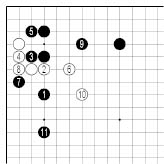 Dia. 5
Dia. 5 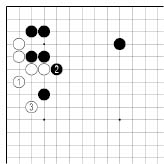 Dia. 6
Dia. 6
 Dia. 7
Dia. 7
Sequence dissection
J-tewari (â¢ùÜ), C-shouge (â¢ùÜ)£¬K-¼ö ³ª´©±â
A way of analyzing the relative efficiency of plays.
The process is, first to take away an equal number of stones of both colors from a position. Then evaluate whether the remaining stones are working efficiently, in order to decide which side made the better moves. Secondly, the order of plays is inverted, to see whether one would still have played in the same way so the actual position results. This reveals something about the actual value of the moves played.
 Dia. 1
Dia. 1  Dia. 2
Dia. 2
For example, if one asks to whom the sequence shown in Dia. 1 is favorous, it is not difficult to answer. Since the sequence in Dia. 2 is a pattern, the exchange of ¡®a¡¯ and ¡®b¡¯ is not necessary, and it allows Black to peep at ¡®a,¡¯ the sequence shown in Dia. 1 cannot be good for White.
Settle
J-osamaru (⥪ުë), no C, K-¾ÈÁ¤(äÌïÒ)ÇÏ´Ù
To make a base or an eye space big enough to make two separate eyes whenever one wants.
Shallow
J-asai (?ª¤), C-qian (?), K-¾è´Ù
Said of a reducing move that does not go deep enough into an enemy position.
 Dia. 1
Dia. 1  Dia. 2
Dia. 2
White 1 in Dia. 1 is considered shallow, since he can invade deep into the Black¡¯s framework with 1 and live as shown in Dia. 2.
Opp. Deep
Shape
J-katachi (û¡), C-qixing (Ѥû¡), K-¸ð¾ç (Ù¼åÆ)
The arrangement of stones, usually said of stones of the same color in one local area.
If stones have ¡®good shape,¡¯ it means that they can make eyes easily or maintains a certain amount of flexibility.
The Korean ¡®¸ð¾ç,¡¯ meaning literally ¡®shape,¡¯ is spelled with the same Chinese characters ¡®Ù¼åÆ¡¯ as the Japanese ¡®moyo.¡¯ So it also has the same meaning as ¡®moyo¡¯, or ¡®framework.¡¯ But we use shape to mean stones in a smaller area and ¡®framework¡¯ to mean stones that map out a large area.
Shortage of liberties
No J, C-qi bugou (?Üô?), K-¼öºÎÁ· (â¢Üôðë)
A condition that one group of stone has less liberties than the opponent¡¯s group in a capturing race.
Cf. self-atari
Shorten the number of liberties
No J, C-jinqi (??), K-¼ö ÁÙÀ̱â
To fill the opponent¡¯s liberties one by one in capturing race.
Shoulder-hit
J-kata (Ì·), C-jianchong (Ì·?), K-¾î±ú ¤±â
A move made at a point diagonally above an opposing stone.
 Dia. 1
Dia. 1
Shusaku¡¯s diagonal move
See Shusaku opening.
Shusaku opening
â³óþ×µ
An opening invented by Shusaku, characterized by 3-4 points rotating through three corners, as Black 1, 3, and 5 in Dia. 1.
It is also called the ¡®1-3-5 opening.¡¯
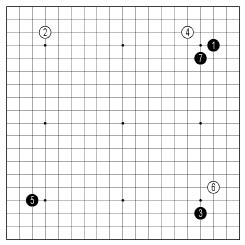 Dia. 1
Dia. 1
Shusaku¡¯s diagonal move
Black 7 in the diagram above is known as the Shusaku¡¯s diagonal move and characterizes the Shusaku opening.
Side
J-hen (?), C-bian (?)£¬K-º¯(Ü«)
A term that indicates an area near the edge of a board between two corners.
With the corners, the sides are strategically important from the viewpoint of settling or making profit because just three walls are needed to secure territory on them. There are four sides on Go board, upper, lower, left, and right.
<º¯ ±×¸²>
Side attachment
See attach.
Sideburn
J-kobin (á³?), C-no, K-±Í¹Ø¸Ó¸®
An attack that breaks the eye shape of the opponent by putting a stone where the opponent can make a tiger¡¯s mouth.
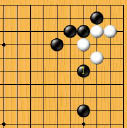 Dia. 1
Dia. 1
It is distinguished from jaw attack which strikes from below.
Sleeper
Stones positioned in the opponent¡¯s area waiting for a chance to be used later.
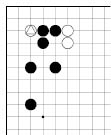 Dia. 1
Dia. 1 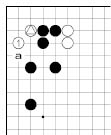 Dia. 2
Dia. 2
The marked white stone in Dia. 1 is a sleeper and this stone can be awakened with 1 or ¡®a¡¯ in Dia. 2 if the situation around here changes.
Slide
J-hashiri (ñ˪ê), suberi (üÁªê), no C, K-´Þ¸®´Ù, ¹Ì²ô·¯Áö´Ù
To intrude into the opponent¡¯s territory near the edge by using a knight¡¯s or a large knight¡¯s move.
The Japanese and the Korean words literally mean ¡®running¡¯ or ¡®gliding.¡¯
Knight¡¯s slide
J-keima hashiri (ÌýØ©ñ˪ê), no C, K-³¯ÀÏÀÚ ´Þ¸²
White 1 in Dia. 1 is a knight¡¯s slide.
 Dia. 1
Dia. 1
Large knight¡¯s slide
J-ogeima hashiri (ÓÞÌýØ©ñ˪ê), no C, K-´«¸ñÀÚ ´Þ¸²
White 1 in Dia. 1 is a large knight¡¯s slide.
 Dia. 1
Dia. 1
Snapback
J-uttegaeshi (öèªÃªÆÚ÷ª·), C-daopu (Óî?), K-ȯ°Ý (ü½Ìª)
A shape in which capturing an enemy stone puts the capturing stones in atari.
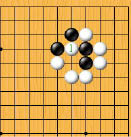 Dia. 1
Dia. 1 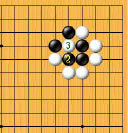 Dia. 2
Dia. 2
In Dia. 1, two black stones seem to be saved by capturing White 1. Actually, however, Black 2 in Dia. 2 causes self-atari to Black, so all three black stones will be captured by White 3.
Double-Snapback
Black cannot play ¡®a¡¯ nor ¡®b¡¯. He is caught in double-snapback.
 Dia. 1
Dia. 1
Solid connection
See connect.
Spin around
J-gurugurumawashi, C-gunda (?öè)£¬K-ȸµ¹ÀÌ
A series of plays, which continuously threatens the opponent¡¯s stones and leaves them in a clump.
 Dia. 1
Dia. 1  Dia. 2
Dia. 2
All three Asian terms mean literally ¡®rolling up.¡¯
Square four
No J, C-bansi (÷ùÞÌ), K-Á¤»ç±Ã(ïáÞÌÏà), ÆÇ»ç±Ã(÷ùÞÌÏà)
An square eye space made up of two by two points.
A square four is dead because it needs two consecutive moves to make two separate eyes.
 Dia. 1
Dia. 1
Squeeze
J-shiboru (ôóªë), C-shoujin (â¥?), K-Á¶¿© ºÙÀÌ´Ù
To force the opponent to capture sacrificed stones thereby building a strong wall on the outside.
 Dia. 1
Dia. 1  Dia. 2
Dia. 2
 Dia. 3
Dia. 3
Black squeezes the white stones with 1 to 5 in Dia. 1 by sacrificing two marked stones. White, being driven to atari, cannot help but to capture the two black stones with 6 and 8 as shown in Dia. 2. With the sequence to 11 in Dia. 3, the white stones have become a dumpling shape and Black has made a strong wall on the outside.
Stand Abreast
J-narabi (?ªÓ), C-bing (?), no K
One of defense methods stretching from a friendly stone instead of blocking the enemy stone directly when the enemy attempts to invade with knight¡¯s cap as Black 1 in the two diagrams below.
 Dia. 1
Dia. 1  Dia. 2
Dia. 2
The characteristic of this move is not to touch the enemy stone and therefore not to give him a chance to develop through proper responses.
Star formation
J-rensei (ææàø), C-lianxing (?àø), K-¿¬¼º(ææàø)
¡®ææàø¡¯ means literally ¡®series of stars,¡¯ and in Go, it refers to the opening pattern occupying star points on one side of the board. This formation is preferred by players who like to play for influence.
Two-star formation
J-nirensei (ì£ææàø), C-erlianxing (ì£?àø)£¬K-ÀÌ¿¬¼º(ì£ææàø), ¾çÈÁ¡(å»ü£ïÇ)
An opening strategy in which one player occupies the star points in two adjacent corners.
The Korean ¡®¾çÈÁ¡¡¯ literally means ¡®double-flower point.¡¯
 Dia. 1
Dia. 1
Three-star formation
J-sanrensei (ß²ææàø), C-sanlianxing (ß²?àø), K-»ï¿¬¼º(ß²ææàø)
An opening strategy in which one player occupies all three star points on one side.
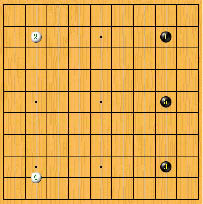 Dia. 1
Dia. 1
Star point
J-hoshi (àø), C-xingwei (àøêÈ), K-ÈÁ¡(ü£ïÇ)
An intersection on which a black point is painted.
There are nine star points on a modern Go borad, but there were four star points on the ancient Chinese board and seventeen on the traditional Korean board.
The Japanese ¡®hoshi¡¯ literally means ¡®star,¡¯ and the English term comes from it. The Korean ¡®ÈÁ¡¡¯ means ¡®flower point¡¯ as the traditional Korean Go boards has flower figure on it.
<¼øÀå ¹ÙµÏÆÇÀÇ ÈÁ¡ »çÁø>
Step ko
A ko situation where a player has to win a series of kos one after the other in order to win the whole situation. There is no term in Asian terminology that covers all the situations like the English ¡®step ko.¡¯
Two-step ko
J-nidan ko (ì£Ó«Ì¤), C-liangshou jie (?â¢Ì¤), K-ÀÌ´ÜÆÐ
A ko situation in which a player must win two kos step by step to achieve the goal of the kos.
 Dia. 1
Dia. 1
To achieve the goal of this ko, that is for White to live with two eyes, White has to win the ko started with White 1 and also the ko with White ¡®a.¡¯ Then, White can get a perfect eye at ¡®b.¡¯
Three-step ko
J-sandan ko (߲ӫ̤), C-sanshou jie (ß²â¢Ì¤), K-»ï´Ü(ß²Ó«)ÆÐ
A ko situation in which a player must win three kos step by step to achieve the goal of the kos.
 Dia. 1
Dia. 1
White has to win three kos at ¡®a,¡¯ ¡®b,¡¯ and ¡®c¡¯ in order to kill the black stones in the corner and to save his stones.
Stone
J-ishi (à´), C-qizi (Ѥí), K-¹ÙµÏµ¹
The name for the pieces used to play Go. In expensive sets, the white stones are usually made from clamshell and the black ones from slate. In cheaper sets, they are made from plastic or ceramic materials.
<»çÁø>
Stone board
K-µ¹¹ÙµÏÆÇ(à´ÏÑ)
A Go board for outdoor play engraved on a flat rock located on the top of a mountain or by a valley with a beautiful landscape.
So far, these stone boards have been found only in Korea.
<»çÁø>
Straight four
J-, C-zhisi (òÁÞÌ), K-Á÷»ç±Ã(òÁÞÌÏà)
An eye space of 1x4 points as shown in Dia. 1. This shape is alive as it stands.
 Dia. 1
Dia. 1
Straight three
No J, C- zhisan (òÁß²), K-Á÷»ï±Ã(òÁß²Ïà)
An eye space of 1x3 points as shown in Dia. 1. This shape needs one more move at ¡®a¡¯ to be alive.
 Dia. 1
Dia. 1
Strengthen
J- kyouka (?ûù), C-buqiang (?Ë), K-°È(Ëûù)ÇÏ´Ù, º¸°(ÜÍË)ÇÏ´Ù
To help a weak group or a vulnerable framework by adding extra defending moves.
 Dia. 1
Dia. 1
White 1 in Dia.1 strengthens his framework by keeping Black from invading at ¡®a.¡¯
Stretch
J-nobiru, C-chang (?)£¬K-´Ã´Ù
To extend solidly from a friendly stone in order to go one line ahead of the opponent as Black 1 in Dia. 1. It is distinguished from ¡®push¡¯ which always follows the opponent¡¯s stretch one line behind. See push
 Dia. 1
Dia. 1
Strong play
No J, C-qiangshou (Ëâ¢)£¬K-°¼ö(Ëâ¢)
A move that can gain the most profit if it succeeds, being a little bit risky but not unreasonable.
Cf. overplay
Style of play
J-, C-qifen (Ѥù¦), K-±âdz(Ѥù¦)
The character of the play of an individual or a group of people.
Influence style
K-¼¼·Â¹ÙµÏ
A style that prefers using influence to get profit to just making territory.
Profit style
K-Áý¹ÙµÏ / ½Ç¸®¹ÙµÏ
A style that prefers territorial gain in hand to just influence or potential.
Fighting style
K-½Î¿ò¹ÙµÏ
A style that prefers starting fights to get profit to waiting a chance to lead a game as keeping the territorial balance.
Suji
J-suji (ÐÉ), C-jin (ÐÉ), K-¸Æ(Øæ)
An important or key place in a local position.
The literal meaning of the Japanese and the Chinese words is ¡®tendon¡¯ or ¡®sinew¡¯, and of the Korean ¡®¸Æ¡¯ is ¡®artery¡¯ or ¡®pulse.¡¯ In Go, they mean an essential point that gives a clue as to how to deal with a certain position.
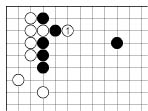 Dia. 1
Dia. 1
White 1 in Dia.1 is a suji to destroy the Black¡¯s framework.
There are compound words such as the Japanese ¡®tesuji (â¢ÐÉ)¡¯ that means ¡®a move that is placed at an important point¡¯ and the Korean ¡®¸Æ¼ö(Øæâ¢)¡¯ that also means the same thing.
Sunjang Baduk (K)
K-¼øÀå¹ÙµÏ(âÞíâ)
Traditional Korean style Go which is characterized by the 16 pre-positioned stones as shown in Dia. 1. The old time Go board of Korea had 17 flower points, and Black must play the first move at one in the center. The way of counting is also different from that in any of the other countries. It only counts the number of intersections which are surrounded by stones of the same color after players have removed all the stones inside territory neither helpful to make the border nor contributing to connecting other stones. In this system, the number of captured stones and prisoners doesn¡¯t matter.
 Dia. 1
Dia. 1
Super ko
J-dokeihanpuku (ÔÒû¡ÚãÜÖ), C-tongxingfanfu (ÔÒû¡Úã?)£¬K-µ¿Çü¹Ýº¹ (ÔÒû¡ÚãÜÖ)
A shape that perpetually repeats the same position in a sequence composed of more than two moves.
It is not regulated by the usual ko rule. If neither player wants to end the repetition, the game ends with no result. The Chinese characters literally mean ¡®repetition of the same shape.¡¯
See eternal life, rotational ko.
Symmetrical shape
J-sayudokei (ñ§éÓÔÒû¡), C-zuoyou tongxing (ñ§éÓÔÒû¡)£¬K-Á¿쵿Çü (ñ§éÓÔÒû¡)
The same shape on both to the left and to the right.
 Dia. 1
Dia. 1
The symmetrical point, i.e. White 1 in Dia. 1 is the vital point of White¡¯s shape.
Territory
J-ji (ò¢), C-kong (Íö), K-Áý(Ê«)
A part of a board that is surrounded by stones of the same color with no enemy stones alive inside it.
The sum of territory is the only factor that decides the result of a game. ¡®Territory¡¯ also can refer to the territorial framework that is not completely surrounded, or ¡®potential territory.¡¯ The Korean word ¡®Áý¡¯ literally means ¡®house¡¯ while the other two terms mean ¡®land.¡¯
Thick
C-hou (ý§), J- atsui (ý§ª¤), K-µÎÅÓ´Ù
A characteristic of stones that are strong and solid with no weaknesses or potential trouble, so they have influence in a certain direction.
Thin
J-usui (Úݪ¤), C-bao (ÚÝ)£¬K-¿¯´Ù
A characteristic of stones that are not strongly constituted, and so exposed to attack.
Thousand-year ko
J-mannenko (زҴ̤), C-wannian jie (زҴ̤)£¬K-¸¸³â(Ø¿Ò´)ÆÐ
A ko which players don¡¯t hurry to start or end, so it takes time to end the ko.
 Dia. 1
Dia. 1  Dia. 2
Dia. 2  Dia. 3
Dia. 3
 Dia. 4
Dia. 4  Dia. 5
Dia. 5
In Dia. 1, it is impossible for Black to win the ko at ¡®a¡¯ by connecting at 1 in Dia. 2 because the whole group would be dead then. The only thing Black can do for saving the group is to continue the ko by playing at 1 in Dia. 3. However, this is troublesome for Black, so he will not hurry to make this ko.
On the contrary, it is not difficult for White to finish the ko. He can always make a dual-life by connecting at 1 in Dia. 4. But, for him there is no reason to hasten to finish the situation. He can take time to weigh the outcome of making a dual-life and of continuing the ko by playing at 1 in Dia. 5.
Three liberties in the corner
J-sekito shibori (à´÷²Îíªê), C-datougui (ÓÞ?С), K-±Í»ï¼ö
A capturing technique in a corner which kills the opponent¡¯s stones by limiting their liberties to less than three.
 Dia. 1
Dia. 1  Dia. 2
Dia. 2  Dia. 3
Dia. 3
Black in diagrams above succeeds in capturing the white stones with the skill of ¡®three liberties in the corner.¡¯ From Black 1 to 11, the number of White¡¯s liberties in the corner cannot exceed by three.
Three-space extension
See extend.
Three-star formation
See star formation.
Three-step ko
See step ko.
Throw-in
J-horikomi (øتê?ªß), C-pu (?), K-¸Ô¿© Ä¡±â
A tactic of sacrificing a stone to reduce the eye shape or liberties of the opponent¡¯s stones.
 Dia. 1
Dia. 1  Dia. 2
Dia. 2
White 1 in Dia. 1 reduces the number of Black¡¯s liberties.
 Dia. 3
Dia. 3  Dia. 4
Dia. 4
White 1 in Dia. 3 creates a false eye in Black¡¯s group.
Thrust
J-de (õó), C-chong (?)£¬K-Â´Ù
A move that tries to go through an opponent¡¯s position.
 Dia. 1
Dia. 1
The Japanese ¡®de¡¯ means literally ¡®go out,¡¯ while the other two terms mean ¡®thrust.¡¯
Thrust-in Thrust-out
White 1 is a thrust-in. Black 1 is a thrust-out.


Tiger¡¯s connection
See connect.
Tiger¡¯s mouth
No J, C-hukou (ûÛÏ¢), K-È£±¸(ûÛÏ¢)
A shape in which three stones of the same color surround one empty intersection.
 Dia. 1
Dia. 1
If the opponent comes in ¡®a,¡¯ it would be killed . That is why this shape is called the ¡®tiger¡¯s mouth.¡¯
Double tiger¡¯s mouth
No J, C-shuang huko (?ûÛÏ¢), K-¾çÈ£±¸(å»ûÛÏ¢)
 Dia. 1
Dia. 1  Dia. 2
Dia. 2
This technique connects stones very strongly.
Tombstone squeeze
See thee liberties in the corner.
Tortoise shell
See turtle back.
Trade
J-furikawaru (òɪêôðªïªë), C-zhuanhuan (??), K-¹Ù²ã Ä¡´Ù
To deliberately gain in one place at the cost of bearing a loss in another.
The objects of a ¡®trade¡¯ is usually territories or groups of stones.
Cf. exchange
Trick move
J-hamete (Êîªáâ¢), C-pianzhao (?ó·), K-²Ä¼ö
A play that tries to take profit, not by making proper moves, but from inducing the opponent to make a mistake.
If the opponent answers a trick move correctly, the one who played it suffers damage.
The Japanese ¡®hamete¡¯ literally means ¡®a move which digs a pitfall.¡¯
Triple-ko
J-sanko (߲̤), C-sanjie xunhuan (߲̤âà?)£¬K-»ïÆÐ
Three kos that happened simultaneously in the same place where both players don¡¯t need to make an external ko threat and can capture and recapture the kos repeatedly.
If neither player stops taking, the game ends without result.
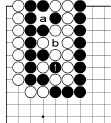 Dia. 1
Dia. 1
Turn
J-magari (Íت¬ªê), C-guai(ÎØ) / qu (ÍØ) / wan (?), K-²¿ºÎ¸®´Ù
A move that makes a triangle shape like White 1 in Dia. 1, or an empty triangle as in White 2 in Dia. 2.
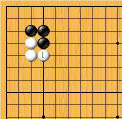 Dia. 1
Dia. 1 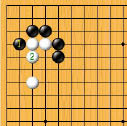 Dia. 2
Dia. 2
Áß±¹¾î ¿Ö ¼¼ °³ÀÎÁö
Cf. bend
Turtle back
J-kamenoko (ÏϪÎË£), C-guike (??), K-°ÅºÏµî
The shape left when two stones are taken off.
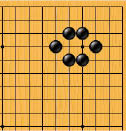 Dia. 1
Dia. 1
This shape is considered to be extremely advantageous. One proverb says ¡®the turtle back is worth 60 points.¡¯ It is also called ¡®tortoise shell.¡¯
Two-space
J-niken (ì£Êà), C-er jian (ìé?)£¬K-¼¼ Ä
A prefix meaning a two-point gap between two stones.
Two-space approach Two-space enclosure



Two-space expansion Two-space jump Two-space pincer



Two-space approach
See approach.
Two-space extension
See extend.
Two-space jump
See jump.
Two-star formation
See star formation.
Two-step-bend
J-nidanbane (ì£Ó«ªÐªÍ), C-lianban (??), K-ÀÌ´Ü Á¥Èû
Two successive bends.
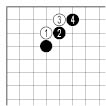 Dia. 1
Dia. 1
The combination of Black 2 and 4 in Dia. 1 is an example.
Two-step ko
See step ko.






